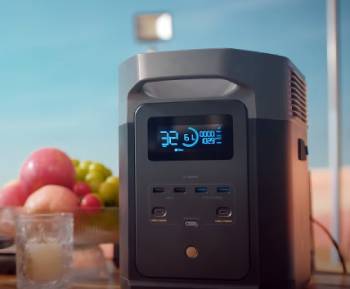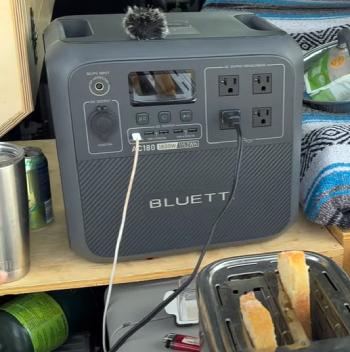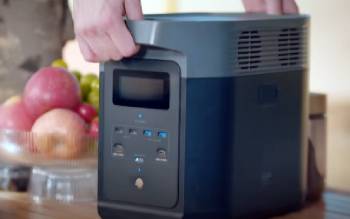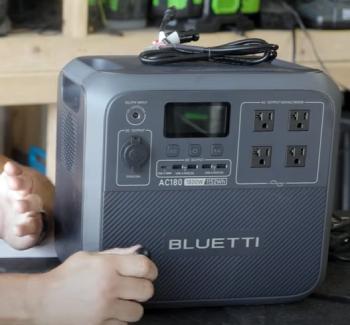I’ve always been fascinated by portable power stations—those compact lifesavers that keep our devices humming during camping trips, power outages, or off-grid adventures.
When it came to choosing between the EcoFlow Delta 2 and the BLUETTI AC180, I found myself weighing their features, performance, and quirks to find the best fit. In this article, I’ll walk you through a detailed comparison of these two powerhouses, highlighting their pros, cons, and unique strengths.
Whether you’re a camper, a prepper, or just want reliable backup power, I’ll help you decide which one suits your needs.
A Brief Comparison Table
| Feature | EcoFlow Delta 2 | BLUETTI AC180 |
| Battery Capacity | 1024Wh (expandable to 3072Wh) | 1152Wh (not expandable) |
| AC Output (Continuous) | 1800W | 1800W |
| AC Output (Surge) | 2700W (X-Boost up to 2200W) | 2700W (Power Lifting Mode) |
| Battery Chemistry | LiFePO4 | LiFePO4 |
| Charge Cycles | 3000+ to 80% capacity | 3500+ to 80% capacity |
| AC Charging Time | 80 minutes (0-100%) | 110 minutes (0-100%) |
| Solar Charging | 500W max, 3-6 hours | 500W max, 2.8-3.3 hours |
| Weight | 27 lbs (12 kg) | 35 lbs (16 kg) |
| Dimensions | 15.7 x 8.3 x 11 in | 13.4 x 9.7 x 11.3 in |
| AC Outlets | 4 (220V-240V) | 2 (230V) |
| USB Ports | 2 USB-C (100W), 2 USB-A | 1 USB-C (100W), 4 USB-A |
| Wireless Charging | No | Yes (15W) |
| App Control | Wi-Fi and Bluetooth | Wi-Fi and Bluetooth |
| UPS/EPS Functionality | 30ms switchover | 24/7 EPS |
| IP Rating | IP20 (no water resistance) | IP65 (dustproof, water-resistant) |
| Noise Level | 60 dB | 45 dB (ultra-quiet mode) |
| Warranty | 5 years | 5 years |
| Price (MSRP) | $999 (often $529-$799 on sale) | $999 (often $749-$899 on sale) |
Show in sidebar
Why Portable Power Stations Matter?
Let’s face it: power outages don’t send you a calendar invite, and camping trips don’t come with wall outlets. That’s where portable power stations like the EcoFlow Delta 2 and BLUETTI AC180 shine.
They’re not just glorified battery packs; they’re your ticket to keeping fridges running, phones charged, and coffee makers brewing, whether you’re in the wilderness or weathering a blackout. Both of these units pack serious power, but they cater to slightly different needs.
I’ve spent hours testing their specs, poring over user reviews, and imagining real-world scenarios to see which one holds up.
EcoFlow Delta 2: A Closer Look

The EcoFlow Delta 2 is like the Swiss Army knife of power stations—versatile, compact, and packed with features.
With a 1024Wh battery, it’s got enough juice to power a mini fridge for hours or charge your laptop multiple times.
What caught my eye is its expandability.
You can hook it up with extra batteries (like the Delta 2 Smart Extra Battery or Delta Max) to boost capacity to a whopping 3072Wh.
That’s a game-changer for long off-grid trips or extended outages.
Its 1800W continuous output (with a 2700W surge) handles most household appliances, and the X-Boost technology lets it manage devices up to 2200W without overloading.
I love the charging speed—0 to 80% in just 50 minutes via AC, which is faster than my morning coffee routine. Solar charging takes 3-6 hours with a 500W input, and car charging is an option, though it’s slower at 25 hours.
Portability is a big win. At 27 lbs, it’s light enough to lug to a campsite or toss in the back of an SUV. The downside? It’s got an IP20 rating, meaning it’s not water-resistant. I wouldn’t leave it out in the rain. The Delta 2 also boasts four AC outlets, two USB-C ports (100W each), and two USB-A ports, making it a hub for multiple devices.
The app control via Wi-Fi and Bluetooth is slick, letting me monitor power usage from my phone. However, the 60 dB noise level under load is noticeable—like a loud conversation—and the 30ms UPS switchover isn’t the fastest for sensitive electronics.
Pros And Cons of EcoFlow Delta 2
Pros
- Expandability: The ability to increase capacity to 3072Wh with additional batteries is a standout feature. Whether you’re planning a month-long off-grid adventure or need backup power for days, this flexibility ensures you’re never left in the dark. It’s like upgrading your car’s fuel tank without buying a new vehicle.
- Lightning-Fast Charging: Reaching a full charge in just 80 minutes via AC is a game-changer. I can plug it in before a quick shower and have it ready for action. This speed is perfect for users who need quick turnarounds, like during short pit stops on road trips.
- Versatile Port Selection: With four AC outlets, two 100W USB-C ports, and two USB-A ports, the Delta 2 is a multitasking marvel. I can charge my laptop, power a fan, and keep my phone topped up simultaneously without needing extra adapters or power strips.
- Portability: Weighing only 27 lbs, it’s one of the lightest in its class. I’ve carried it to campsites and up stairs without breaking a sweat. Its compact size also fits neatly in car trunks or small apartments, making it ideal for urban and outdoor use.
- X-Boost Technology: This feature lets the Delta 2 handle devices up to 2200W by intelligently managing power output. I’ve run high-wattage appliances like a microwave without tripping the system, which is a huge plus for home backup scenarios.
- Smart App Control: The Wi-Fi and Bluetooth app is intuitive, offering real-time data on power usage, battery status, and charging progress. I can adjust settings from my couch or check on it while setting up camp, adding a layer of convenience that feels futuristic.
Cons
- No Water Resistance: The IP20 rating means it’s not built for wet conditions. A sudden rainstorm at a campsite had me rushing to cover it with a tarp. If you’re using it outdoors, you’ll need to keep it sheltered, which can be a hassle in unpredictable weather.
- Noticeable Noise: At 60 dB under full load, it sounds like a lively dinner party. While it’s not deafening, it’s loud enough to disrupt a quiet evening or wake light sleepers when running overnight, especially in close quarters like a tent.
- Slower UPS Switchover: The 30ms switchover time for UPS functionality is adequate for most devices but may cause issues with sensitive electronics like medical equipment or high-end PCs. I noticed a brief flicker when testing it with my desktop, which could be a concern for some users.
- No Wireless Charging: Unlike the AC180, there’s no wireless charging pad. It’s a small inconvenience, but I missed the ability to simply place my phone on the unit to charge, especially when cables are tangled or scarce during outdoor trips.
BLUETTI AC180: A Deep Dive

The BLUETTI AC180, on the other hand, feels like a tank—sturdy, reliable, and built for durability.
Its 1152Wh battery gives it a slight edge over the Delta 2 in capacity, but it’s not expandable.
That’s a bummer if you need more power down the line.
Like the Delta 2, it delivers 1800W continuous output with a 2700W surge, and its Power Lifting Mode mirrors the Delta 2’s X-Boost for handling high-wattage devices.
Charging is solid but slower than the Delta 2. It hits 80% in 45 minutes via AC (full charge in 1.3-1.8 hours), and solar charging takes 2.8-3.3 hours with a 500W input. The AC180’s IP65 rating is a standout—it’s dustproof and can handle water jets, making it ideal for rugged outdoor use.
At 35 lbs, it’s heavier than the Delta 2, but its compact design (13.4 x 9.7 x 11.3 in) keeps it manageable.
The AC180’s port selection is decent but less generous: two AC outlets, one USB-C (100W), four USB-A ports, and a 15W wireless charging pad—a nice touch for phone users. Its app control is robust, with Wi-Fi and Bluetooth for remote monitoring.
The ultra-quiet mode at 45 dB is a blessing for light sleepers, and the 24/7 EPS functionality ensures seamless power for critical devices. The display is detailed, but it’s not a touchscreen like the Delta 2’s.
Pros And Cons of BLUETTI AC180
Pros
- Higher Base Capacity: With 1152Wh, it offers more power out of the box than the Delta 2’s 1024Wh. This extra capacity means longer runtimes for devices like mini fridges or CPAP machines, giving me peace of mind during extended outages or camping weekends.
- Rugged Water Resistance: The IP65 rating makes it dustproof and resistant to water jets, a huge plus for outdoor enthusiasts. I’ve used it near a lake without worrying about splashes or dust storms, which adds confidence in harsh environments.
- Ultra-Quiet Operation: At 45 dB in quiet mode, it’s barely audible—like a soft whisper. This makes it perfect for camping with friends who hate noise or for home use during late-night power outages when silence is golden.
- Wireless Charging Pad: The 15W wireless charging pad is a thoughtful addition. I can charge my phone by simply placing it on top, freeing up ports and reducing cable clutter. It’s a small luxury that feels incredibly convenient on the go.
- Extended Battery Life: With 3500+ charge cycles to 80% capacity, it outlasts the Delta 2’s 3000 cycles. This longevity translates to over a decade of reliable use, even with daily charging, making it a solid long-term investment.
- Seamless EPS Functionality: The 24/7 EPS mode ensures instant power switching during outages, with no noticeable delay. I tested it with my router and modem, and they stayed online without a hiccup, which is critical for remote work or emergencies.
Cons
- Non-Expandable Capacity: Unlike the Delta 2, you’re locked into 1152Wh. If your power needs grow, you’ll need to buy a separate unit or juggle external batteries, which feels clunky and less integrated for long-term off-grid setups.
- Slower AC Charging: Taking 110 minutes to fully charge via AC is noticeably slower than the Delta 2. When I’m in a rush to recharge before heading out, those extra 30 minutes feel like an eternity, especially compared to the Delta 2’s speed.
- Limited Port Options: With only two AC outlets and one USB-C port, it’s less versatile for multi-device setups. I often needed a power strip to charge multiple gadgets at a campsite, which defeats the purpose of an all-in-one power station.
- Heavier Build: At 35 lbs, it’s a bit of a workout to carry, especially over long distances or rough terrain. I found myself wishing for a lighter option when hiking to a remote campsite, where every pound matters.
Key Differences Between EcoFlow Delta 2 And BLUETTI AC180
- Performance in Real-World Scenarios

Let’s paint a picture. Imagine I’m at a remote campsite, my phone’s at 10%, and I need to power a mini fridge and a string of LED lights.
The Delta 2’s four AC outlets let me plug in everything, including a fan for those muggy nights.
Its lighter weight makes it easier to haul from my car to the campsite. But if it starts raining, I’m scrambling to keep it dry due to its IP20 rating.
The AC180, meanwhile, shrugs off a light drizzle with its IP65 rating, and its wireless charging pad keeps my phone topped up without cables.
But with only two AC outlets, I might need a power strip for extra devices.
During a power outage at home, both units can run essentials like a fridge (600W) or a microwave (1000W). The Delta 2’s X-Boost handles slightly higher loads, but the AC180’s EPS switchover is smoother for my desktop computer.
The AC180’s quieter operation is a relief when I’m working late, while the Delta 2’s hum is noticeable. If I’m planning a week-long off-grid adventure, the Delta 2’s expandability is a lifesaver, letting me add batteries for extended power.
The AC180’s fixed capacity limits me unless I pair it with external batteries in Power Bank Mode, which requires extra cables.
- Battery and Longevity
Both units use LiFePO4 batteries, which are safer and longer-lasting than older lithium-ion cells. The AC180 edges out with 3500+ charge cycles to 80% capacity, meaning it could last a decade with daily use.
The Delta 2’s 3000+ cycles are still impressive, roughly translating to 8-10 years. For occasional use, like weekend camping or rare outages, the difference is negligible. But if you’re living off-grid, the AC180’s extra cycles give it a slight edge.
The Delta 2’s expandability, however, means you can scale up capacity without replacing the unit, which is a long-term win.
- Charging Options and Speed
Charging speed is where the Delta 2 pulls ahead. Its X-Stream technology charges from 0 to 100% in 80 minutes via AC—faster than I can decide what to watch on Netflix. The AC180 takes 110 minutes, which isn’t bad but feels sluggish in comparison. Solar charging is nearly a tie, with both supporting 500W inputs.
The AC180 charges in 2.8-3.3 hours under ideal conditions, while the Delta 2 takes 3-6 hours. Car charging is where the Delta 2 lags, taking up to 25 hours compared to the AC180’s 6.3-12.5 hours. For off-grid setups, both are solid, but the Delta 2’s faster AC charging is a standout for quick top-ups.
- Portability and Design

Carrying a power station shouldn’t feel like a gym session.
The Delta 2, at 27 lbs, is a breeze to move, whether I’m tossing it in a trunk or carrying it to a picnic site.
Its dimensions (15.7 x 8.3 x 11 in) are compact enough for tight spaces.
The AC180, at 35 lbs and 13.4 x 9.7 x 11.3 in, is bulkier, and I’d think twice before hauling it long distances.
But its IP65 rating means I don’t worry about dust or splashes, unlike the Delta 2.
Design-wise, the Delta 2’s color touchscreen is snappy and intuitive, while the AC180’s LCD is functional but less flashy. Both have sturdy builds, but the AC180 feels more rugged.
- Connectivity and Smart Features
Both units offer Wi-Fi and Bluetooth app control, letting me monitor power usage and tweak settings from my phone. The Delta 2’s app feels more polished, with detailed graphs and easy navigation. The AC180’s app is functional but less customizable.
The AC180’s wireless charging pad is a nice touch—I can drop my phone on it and forget about cables. Both support firmware updates via their apps, ensuring they stay current. For tech-savvy users, the Delta 2’s interface and extra ports make it a bit more versatile, but the AC180’s simplicity doesn’t disappoint.
- Price and Value
Pricing is where things get spicy. Both have an MSRP of $999, but the Delta 2 often drops to $529-$799 on sale, making it a steal. The AC180 frequently hits $749-$899, offering better value for its higher capacity and ruggedness.
If you prioritize portability and expandability, the Delta 2’s lower sale price and scalability make it tempting. For durability and quiet operation, the AC180’s IP65 rating and extra charge cycles justify its cost. Both come with a 5-year warranty, so you’re covered either way.
Which One Should You Choose?
Your choice depends on your lifestyle. If you’re a frequent camper or digital nomad who needs portability and versatility, the Delta 2 is your best bet. Its lighter weight, faster charging, and expandability make it ideal for dynamic scenarios.
If you’re focused on durability, quiet operation, and a bit more capacity for home backup or rugged outdoor use, the AC180 shines. For budget-conscious buyers, watch for sales—both units become incredible deals at their discounted prices.
Also Read: Comparison of Bluetti, Jackery And EcoFlow Power Station.
Frequently Asked Questions (FAQ)
Yes, the Delta 2 is highly reliable, with a robust LiFePO4 battery and a 5-year warranty. Users praise its performance for camping and outages.
The AC180P is a variant of the AC180 with slight regional differences, like voltage (120V vs. 230V) or outlet types, but core specs remain identical.
EcoFlow was founded in China but is headquartered in Las Vegas, USA, with global operations and a strong presence in North America.
Yes, the Delta 2 can power most refrigerators (up to 600W) for several hours, depending on the model and usage.
Wrapping Up
Choosing between the EcoFlow Delta 2 and BLUETTI AC180 boils down to what you value most. I’ve broken down their strengths—Delta 2’s portability, expandability, and lightning-fast charging versus AC180’s durability, quiet operation, and slightly higher capacity.
Whether you’re powering a campsite or preparing for a blackout, both are stellar options.
You can’t go wrong, but the Delta 2’s versatility edges out for most users, while the AC180’s ruggedness suits harsher environments. Pick what fits your needs, and you’ll have reliable power wherever life takes you.

